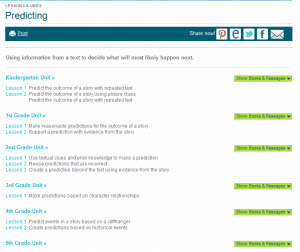Common Core Reading Lessons: Predicting
 Using information from a text to decide what will most likely happen next.
Using information from a text to decide what will most likely happen next.
Predicting Lessons - Covers kindergarten through sixth grade. Examples: Predict the outcome of a story with repeated text. Revise predictions that are incorrect. Make predictions based on character relationships. Create predictions based on historical events.
Integration of Knowledge and Ideas
CCSS.ELA-Literacy.RL.K.7 With prompting and support, describe the relationship between illustrations and the story in which they appear (e.g., what moment in a story an illustration depicts).
Presentation of Knowledge and Ideas
CCSS.ELA-Literacy.SL.K.5 Add drawings or other visual displays to descriptions as desired to provide additional detail.
Key Ideas and Details
CCSS.ELA-Literacy.RL.1.1 Ask and answer questions about key details in a text.
CCSS.ELA-Literacy.RL.1.2 Retell stories, including key details, and demonstrate understanding of their central message or lesson.
CCSS.ELA-Literacy.RL.1.3 Describe characters, settings, and major events in a story, using key details.
Integration of Knowledge and Ideas
CCSS.ELA-Literacy.RL.1.7 Use illustrations and details in a story to describe its characters, setting, or events.
Comprehension and Collaboration
CCSS.ELA-Literacy.SL.1.2 Ask and answer questions about key details in a text read aloud or information presented orally or through other media.
Vocabulary Acquisition and Use
CCSS.ELA-Literacy.L.1.4 Determine or clarify the meaning of unknown and multiple-meaning words and phrases based on grade 1 reading and content, choosing flexibly from an array of strategies.
CCSS.ELA-Literacy.L.1.4a Use sentence-level context as a clue to the meaning of a word or phrase.
CCSS.ELA-Literacy.L.1.5 With guidance and support from adults, demonstrate understanding of word relationships and nuances in word meanings.
CCSS.ELA-Literacy.L.1.5c Identify real-life connections between words and their use (e.g., note places at home that are cozy).
Integration of Knowledge and Ideas
CCSS.ELA-Literacy.RL.2.7 Use information gained from the illustrations and words in a print or digital text to demonstrate understanding of its characters, setting, or plot.
Comprehension and Collaboration
CCSS.ELA-Literacy.SL.2.2 Recount or describe key ideas or details from a text read aloud or information presented orally or through other media.
Integration of Knowledge and Ideas
CCSS.ELA-Literacy.RI.2.8 Describe how reasons support specific points the author makes in a text.
Key Ideas and Details
CCSS.ELA-Literacy.RL.3.3 Describe characters in a story (e.g., their traits, motivations, or feelings) and explain how their actions contribute to the sequence of events.
Key Ideas and Details
CCSS.ELA-Literacy.RL.4.1 Refer to details and examples in a text when explaining what the text says explicitly and when drawing inferences from the text.
CCSS.ELA-Literacy.RL.4.2 Determine a theme of a story, drama, or poem from details in the text; summarize the text.
Range of Reading and Level of Text Complexity
CCSS.ELA-Literacy.RL.4.10 By the end of the year, read and comprehend literature, including stories, dramas, and poetry, in the grades 4-5 text complexity band proficiently, with scaffolding as needed at the high end of the range.
Vocabulary Acquisition and Use
CCSS.ELA-Literacy.L.4.4 Determine or clarify the meaning of unknown and multiple-meaning words and phrases based on grade 4 reading and content, choosing flexibly from a range of strategies.
CCSS.ELA-Literacy.L.4.4a Use context (e.g., definitions, examples, or restatements in text) as a clue to the meaning of a word or phrase.
CCSS.ELA-Literacy.L.4.6 Acquire and use accurately grade-appropriate general academic and domain-specific words and phrases, including those that signal precise actions, emotions, or states of being (e.g., quizzed, whined, stammered) and that are basic to a particular topic (e.g., wildlife, conservation, and endangered when discussing animal preservation).